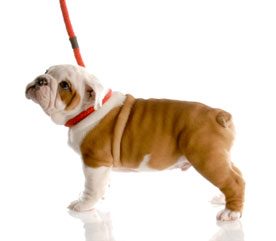Dog Training Collars: What You Need to Know
There is a dizzying array of collars on today’s market for dogs of all ages, shapes, sizes, and temperaments. But if you’re looking for a collar specifically for training purposes, which one will be right for your dog?

Basic Obedience Training
For basic obedience training for most dogs, including puppies, a basic neck collar will most likely suffice. They’re also exactly the same type of collar your dog will wear while being walked, traveling, or just lounging on the couch at home. Available at all pet supply stores, these collars come with a standard or quick-release buckle, a loop to hold identification/medical information, and another loop to which a leash can be fastened. If you and your dog are enrolled in a dog training class, the instructor will provide you with help in deciding which collar would be best for your own dog.
Specialty Training Devices
Each dog is different and it’s not unusual that something beyond a basic training collar will be required. A body harness fits around the chest and back area with loops on top for ID and leash, and sometimes a handle, similar to that on a suitcase.
A body harness can be a good solution for dogs that choke or pant excessively on a basic neck collar which is often the case with dogs suffering from compromised breathing (ie: Bulldogs, Pugs).
If all that choking and panting is due to a strong dog who hasn’t learned to slow down, however, you’ll need a combination of basic collar/leash and harness/leash. The collar’s leash gives you the control you’ll need while the harness’s leash will help take pressure off the dog’s neck.
Strong or easily distracted dogs can do well with a head halter. Used in conjunction with a basic neck collar/leash, a head halter is based on the theory “If you control the head, you control the body.” If your dog can’t resist chasing a bicycle or rounding up a group of unwilling children, the head harness is used to re-direct the dog’s focus. Again, you’ll be dealing with two leashes but many people find it to be a good training aid while serving double-duty as added protection against neck injuries.
Note: Body and head harnesses are to be used for training and walking purposes only. They shouldn’t be worn by unsupervised dogs inside or outside the house where they may become entangled in objects such as bushes and fences or coffee tables and doorknobs, other dogs or the family cat.
There are other training collars available that choke, shock, pinch and even spray chemicals into a dog’s face. Dog trainers who advocate positive methods have deemed these to be unnecessary, injurious, and detrimental to a dog’s physical and mental health. They can also lead to an aggressive dog which can create a whole new set of training problems.
Ask for Recommendations
Before shopping for a training collar, ask your veterinarian or dog trainer for recommendations then take your dog to the pet supply store for a personal fitting.
As your canine buddy grows into the perfect example of a well-trained dog or any medical issues come into play (ie: temporary use of an Elizabethan collar) you may want to consider a change in collars to suit his current needs.



